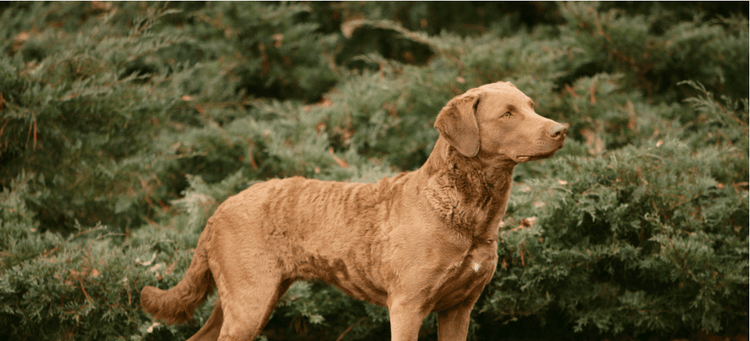
Choosing a Chesapeake Bay Retriever
The Chesapeake Bay retriever, also known as the Chessie, has been around since the early 1800s. To fully understand the Chessie, one must understand the environment in which this breed was developed.
History and Origin
The Chesapeake Bay is on the East Coast of the United States. This region has exceptionally harsh and unforgiving winters. The icy conditions make it difficult for many breeds to work in this area. This region also boasts thousand of migratory game birds, making it a hunter’s paradise.
Chessies were bred to withstand these harsh conditions. They are very well equipped for this environment with a thick, warm, waterproof coat. They have deep chests for endurance and webbed feet for swimming.
As with most purebred dogs, the stories surrounding the Chessie’s exact origin are speculative at best. There are legends of shipwrecks and orphaned puppies. Most likely, the Chessie is descended from the Labrador retriever and other hearty dogs such as coonhounds and water spaniels. By the early 1900s, the Chessie that we know today had emerged.
Appearance
Chessies have an incredibly commanding appearance. They have a broad, sizeable skull and ample jaws capable of carrying large game birds. These dogs are strong, very well muscled, have stocky legs and a powerful body structure. The deep chest allows the lungs to fully expand for endurance.
The Chessie’s coat is dense, short and wavy. It comes in many shades of brown including dead grass, sedge and liver. The wooly hair serves as a waterproof barrier and an insulator for icy conditions.
The Chessie’s gaze is intense and intelligent. The eyes are usually yellow or amber.
They typical Chessie weighs 55 to 75 pounds and stand 21 to 26 inches at the shoulder.
Personality
Chessies have a bright, happy disposition. These dogs are incredibly loyal. They love to work and are affectionate with their family members. These dogs are water lovers. They are known for jumping into lakes and pools just for the heck of it. They are very brave and will stand up to any challenge. These dogs are not for the novice owner. Their high energy and assertiveness demand an active, attentive owner.
Home and Family
Chessies are good with children when raised with them. They are protective of their “pack” and make excellent watchdogs. They are friendly with strangers and do not tend to bite. These dogs do not thrive well when kenneled; they need a social life. As puppies, Chessies are notorious chewers.
Training
These dogs are excellent hunters, but it is important to start early, as they can be stubborn. Chessies also excel at obedience and search and rescue.
Common Diseases and Disorders
In general, the Chesapeake Bay retriever is a healthy however, the following diseases or disorders have been reported:
- Gastric torsion (bloat) is a life-threatening sudden illness associated with the stomach filling with air and twisting.
- Hip dysplasia is a malformation of the hip joint that results in pain, lameness and arthritis.
- Osteochondrosis is a defect of the cartilage and can cause lameness and pain in the joints.
- Entropion is a problem with the eyelid that causes inward rolling. Lashes on the edge of the eyelid irritate the surface of the eyeball and may lead to more serious problems.
- Cataracts cause a loss of the normal transparency of the lens of the eye. The problem can occur in one or both eyes and can lead to blindness.In addition, although these occur infrequently, the following disorders have also been reported:
- von Willebrand’s Disease is a disorder that results in the inability to clot blood. Affected animals will bleed extensively following trauma or surgery.
- Progressive retinal atrophy (PRA) is a disease that causes nerve cells at the back of the eye to degenerate. The condition usually begins in older pets and can lead to blindness.
- Cerebellar abiotrophy is a progressive nervous system abnormality that begins with incoordination and progresses until the dog is completely incapacitated.
- Degenerative myelopathy is a progressive degenerative disease of the spinal cord that slowly results in weakness and eventually inability to use the rear legs.
- Ruptured cranial cruciate ligament is a problem that results from tearing of the cruciate ligament in the knee, causing lameness that may be severe .
- Distichiasis is a condition in which there is growth of extra eyelashes from the glands of the upper or lower eyelid.\
Life Span
- The life span of the Chessie is approximately 12 to 13 years.
- We realize that each dog is unique and may display other characteristics. This profile provides generally accepted breed information only.